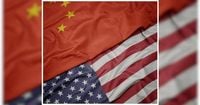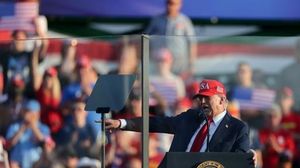In a pivotal moment for global trade dynamics, U.S. Treasury Secretary Scott Bessent is set to meet with Chinese Vice Premier He Lifeng in Switzerland this weekend, May 10-11, 2025, to negotiate a resolution to the ongoing trade war between the two economic giants. This meeting comes in the wake of significant shifts in trade patterns, marked by a surprising 8% surge in China’s exports for April, a figure that vastly exceeded the expected 2% growth.
Prominent economist Mohamed A. El-Erian has raised concerns about the implications of this export surge for U.S. domestic industries, particularly as it coincides with a substantial 21% drop in Chinese sales to the United States. El-Erian noted on social media, "This surge comes as China redirects more of its exports to other countries, which is likely to exacerbate concerns about the adverse implications for certain domestic industries." His analysis suggests that the redirection of Chinese goods could intensify competition for U.S. producers, impacting pricing and market viability.
As trade tensions escalate, Vice Foreign Minister Hua Chunying expressed confidence in China’s ability to manage U.S. trade issues, stating, "We have no fear," during a press conference in southwestern China. Hua emphasized that the current U.S. trade policy cannot be sustained, reflecting a broader sentiment within China that the tariffs imposed by President Donald Trump have created an untenable economic environment.
Trump's administration has faced mounting pressure as economists label the tariffs a "demand shock" that could have far-reaching consequences on the global economy. The U.S. tariffs, which have reached as high as 145%, have not only strained U.S.-China relations but also disrupted supply chains and unsettled financial markets.
The upcoming talks are viewed as a critical step toward de-escalating the trade war, which has already begun to impact various sectors, including furniture, toys, and textiles. Many analysts have downgraded their economic growth forecasts for China, with investment bank Nomura warning that the trade war could result in the loss of up to 16 million jobs.
In a bid to address these economic challenges, China’s central bank recently announced fresh monetary stimulus, signaling the urgency of the situation. Additionally, as major trading partners like Vietnam and India initiate negotiations with Washington, China is keen to secure its position at the negotiating table.
The backdrop of these negotiations is characterized by a complex web of geopolitical factors and historical grievances. Following Trump's imposition of tariffs, Chinese officials have publicly adopted a hardline stance, portraying the U.S. as an imperialist bully. However, internal pressures have prompted a shift towards negotiation, as Beijing grapples with the economic fallout of the trade war.
As the talks approach, both sides appear to be balancing their negotiating tactics. While Trump has indicated a desire for a trade deal, stating, "I think he’s going to want to get to a deal," China's position remains firm. The Chinese Commerce Ministry has articulated that any attempts by Washington to use negotiations as a pretext for continued coercion will be met with refusal, emphasizing that China will not sacrifice its principles.
In a sign of the deep mistrust that defines U.S.-China relations, China's Vice Foreign Minister also highlighted the potential for friction during the talks, particularly regarding a recent U.S. letter demanding action on fentanyl production. This letter was perceived in Beijing as an arrogant attempt to dictate Chinese policy, complicating the diplomatic landscape ahead of the negotiations.
Amid these tensions, the economic stakes are high. Executives from major retailers, including Walmart, have warned that continued tariffs could lead to rising prices and product shortages. This has prompted the U.S. administration to backtrack on some tariff measures, exempting electronics from certain tariffs and reducing impacts on automakers.
As the trade war continues to unfold, both nations are acutely aware of the potential consequences of failure to reach an agreement. The trade relationship between the U.S. and China has shifted dramatically, with a noticeable decline in the percentage of Chinese exports directed toward the U.S. In 2018, over 19% of China’s exports went to the U.S.; by last year, that figure had dropped to less than 15%. Meanwhile, trade with the Association of Southeast Asian Nations has surged by nearly 60% since 2019, indicating a significant pivot in China’s trade strategy.
As Bessent and He prepare for their discussions, the outcome remains uncertain. While both sides may seek to de-escalate tensions, the underlying issues that have fueled the trade war—such as tariffs, intellectual property disputes, and market access—are complex and deeply entrenched. The stakes are high, not just for the U.S. and China, but for the global economy as a whole.
In the lead-up to the talks, observers are keenly watching how both sides will navigate these contentious issues. With Trump’s approval ratings under pressure due to economic concerns, the urgency for a resolution may weigh heavily on his administration. However, Xi Jinping’s steady leadership and commitment to China’s long-term economic goals suggest that he may not be easily swayed by U.S. demands.
As the weekend approaches, the world waits with bated breath to see if these talks will mark a turning point in U.S.-China relations or if they will only serve to highlight the deep divides that still exist between the two superpowers.





